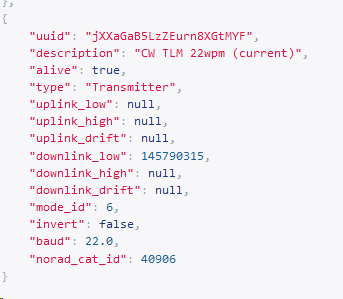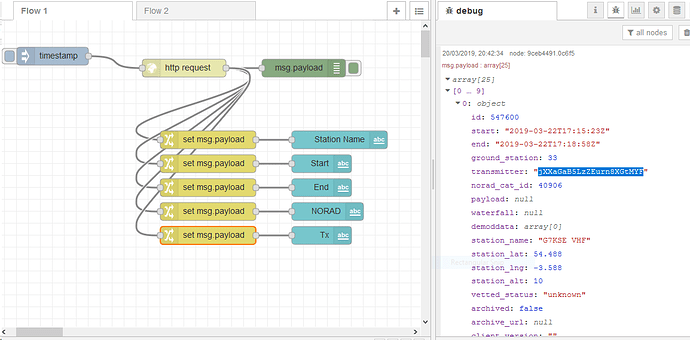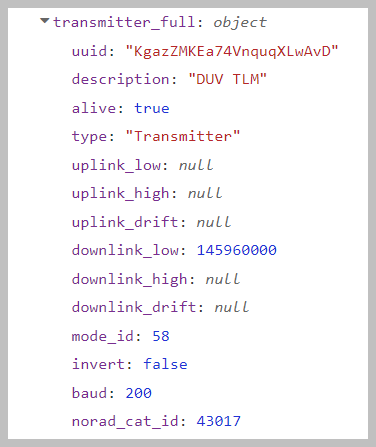and this flow add both: transmitter and satellites to each observation.
[{"id":"d8d2b8b1.4b6988","type":"tab","label":"SatNOGS-3","disabled":false,"info":""},{"id":"ab23037b.cde82","type":"inject","z":"d8d2b8b1.4b6988","name":"","topic":"","payload":"","payloadType":"date","repeat":"","crontab":"","once":false,"onceDelay":0.1,"x":160,"y":280,"wires":[["99f77fd4.74041"]]},{"id":"99f77fd4.74041","type":"http request","z":"d8d2b8b1.4b6988","name":"","method":"GET","ret":"obj","paytoqs":false,"url":"https://network.satnogs.org/api/observations/?id=&ground_station=33&satellite__norad_cat_id=&transmitter=&vetted_status=&vetted_user=&start=&end=","tls":"","proxy":"","authType":"basic","x":330,"y":280,"wires":[["642bf6ce.2f0c38"]]},{"id":"75b54a8f.4ca984","type":"inject","z":"d8d2b8b1.4b6988","name":"","topic":"","payload":"","payloadType":"date","repeat":"","crontab":"","once":true,"onceDelay":"0.5","x":150,"y":200,"wires":[["92584431.b72438"]]},{"id":"77572136.b36d8","type":"debug","z":"d8d2b8b1.4b6988","name":"","active":true,"tosidebar":true,"console":false,"tostatus":false,"complete":"payload","targetType":"msg","x":730,"y":200,"wires":[]},{"id":"642bf6ce.2f0c38","type":"split","z":"d8d2b8b1.4b6988","name":"","splt":"\\n","spltType":"str","arraySplt":1,"arraySpltType":"len","stream":false,"addname":"","x":500,"y":280,"wires":[["6756dd9e.2914e4"]]},{"id":"eed749fb.6857f8","type":"debug","z":"d8d2b8b1.4b6988","name":"","active":true,"tosidebar":true,"console":false,"tostatus":false,"complete":"payload","targetType":"msg","x":930,"y":280,"wires":[]},{"id":"92584431.b72438","type":"http request","z":"d8d2b8b1.4b6988","name":"","method":"GET","ret":"obj","paytoqs":false,"url":"https://db.satnogs.org/api/satellites/","tls":"","proxy":"","authType":"basic","x":330,"y":200,"wires":[["3bc6f88f.57cf48"]]},{"id":"3bc6f88f.57cf48","type":"change","z":"d8d2b8b1.4b6988","name":"","rules":[{"t":"set","p":"satellites","pt":"global","to":"payload","tot":"msg"}],"action":"","property":"","from":"","to":"","reg":false,"x":540,"y":200,"wires":[["77572136.b36d8"]]},{"id":"6756dd9e.2914e4","type":"change","z":"d8d2b8b1.4b6988","name":"","rules":[{"t":"set","p":"payload.satellite_full","pt":"msg","to":"$globalContext(\"satellites\")[norad_cat_id= $$.payload.norad_cat_id]","tot":"jsonata"},{"t":"set","p":"payload.transmitter_full","pt":"msg","to":"$globalContext(\"transmitters\")[uuid= $$.payload.transmitter]","tot":"jsonata"}],"action":"","property":"","from":"","to":"","reg":false,"x":670,"y":280,"wires":[["eed749fb.6857f8"]]},{"id":"737f1a11.320a14","type":"inject","z":"d8d2b8b1.4b6988","name":"","topic":"","payload":"","payloadType":"date","repeat":"","crontab":"","once":true,"onceDelay":0.1,"x":150,"y":160,"wires":[["d614c56e.3bc548"]]},{"id":"126302fb.bbc0dd","type":"debug","z":"d8d2b8b1.4b6988","name":"","active":true,"tosidebar":true,"console":false,"tostatus":false,"complete":"false","x":730,"y":160,"wires":[]},{"id":"d614c56e.3bc548","type":"http request","z":"d8d2b8b1.4b6988","name":"","method":"GET","ret":"obj","paytoqs":false,"url":"https://db.satnogs.org/api/transmitters/","tls":"","proxy":"","authType":"basic","x":320,"y":160,"wires":[["731ca76f.62e938"]]},{"id":"731ca76f.62e938","type":"change","z":"d8d2b8b1.4b6988","name":"","rules":[{"t":"set","p":"transmitters","pt":"global","to":"payload","tot":"msg"}],"action":"","property":"","from":"","to":"","reg":false,"x":520,"y":160,"wires":[["126302fb.bbc0dd"]]}]
It is a pitty that the satellite image is not always available. That would make the dashboard awesome.
This project seems really nice. I feel tempted to build my own ground station. If I can use a discone antena that is lying around then it is missing only to find a RTL SDR dongle.









